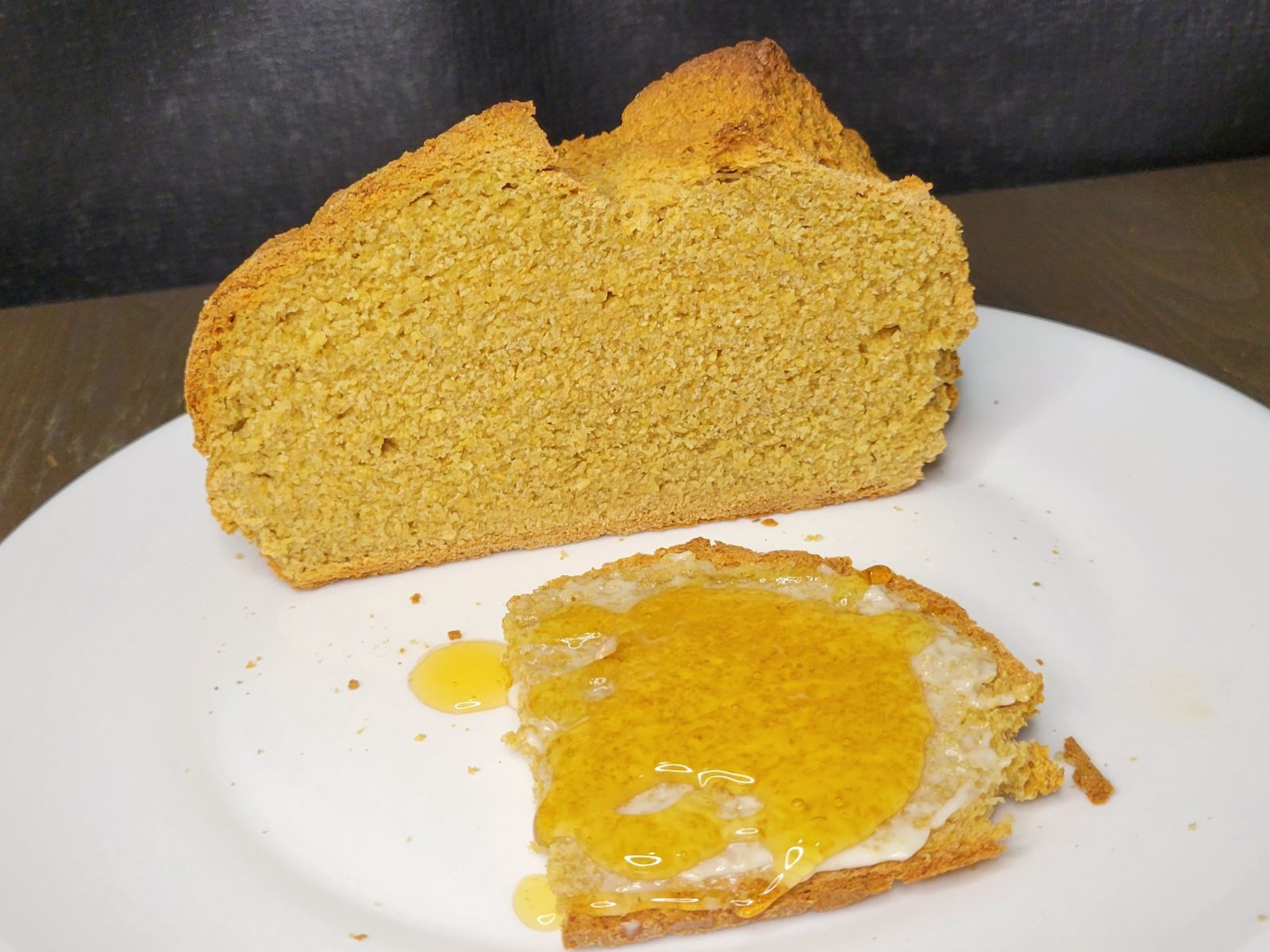How To Make Croissants With Fresh Milled Flour
Croissants made with Fresh Milled Flour are absolutely delicious! They are light, and flaky, oh what a special treat these are! I can’t wait to share my recipe with you, because this recipe was a labor of love for me! I had MANY flops! And I mean MANY! But, I finally mastered the croissant with fresh milled flour, and without sifting! So, I am here to tell you, yes it can be done!

Now, will you get it right your first time? Maybe, maybe not. I have done so many trial and error bakes, and I hope I can share my secrets with you so you can get them just right much quicker than it took me!
If you are intimidated by this recipe, and not quite ready, then I recommend you start with my ruff puff pastry recipe HERE, which is a more basic laminated dough, and is much faster. (I love to make apple turnovers with it!) Don’t be discouraged if they don’t turn out the first time, this has taken me years to perfect!

Secret To Great Croissants
There are a few secrets to making a great croissant. I am here to share a few with you.
- Keeping everything very cold matters! If the butter starts to soften even a little, it is time to pop it back into the fridge to chill before you can keep working with it. Otherwise, the butter melts into the dough and it creates a delicious bread, but no longer laminated. (I will talk about laminated dough in a bit.)
- The Kind of butter matters, I talk about this later.
- Don’t try to rush the process, it is not unheard of to take 3 days to make beautiful croissants. These are not a hurry and get them done in a few hours kind of thing. They are a labor of love.
- Pull them out of the oven a bit early, because overbaking the will make them dry and harden up. So, don’t overbake them if you want a light and squishy croissant. The internal temperature should be between 195*F-200*F in the thickest part. Anymore than that, and they will dry out, and be overbaked.
- Egg wash the top of the croissants twice! This helps form the very thin crispy layer on the outside of the croissant. Also, the egg wash creates an unmatchable shine and beautiful brown color on the exterior.

What Kind Of Butter Do I Need To Make Croissants With Fresh Milled Flour?
Does the kind of butter really matter when making fresh milled flour croissants? Yes, the kind of butter does really matter, and it needs to be a higher quality European butter. The reason for this is because, European butter has a lower moisture content. Alternatively, American Butter has more water in it, and that can cause issues. These issues can be anywhere from the butter leaking out during baking, to the butter melting into the dough and making the end result more like bread, rather than a flaky, layered croissant.
Do I Need To Make A Butter Block To Make Laminated Dough?
Traditionally, laminated doughs like croissants are made with a butter block. It is exactly what it sounds like… a block of butter. But, in my video, I show you a trick that works great as an alternative to making a butter block. I freeze my butter, then grate it into a bowl. Then I put the bowl immediately back into the freezer so it stays super cold, and doesn’t stick together.

What Is Laminated Dough?
A laminated dough is a dough that is basically layered of dough, butter, dough, butter, etc etc. So, it is a bunch of tiny layers of each. So, when the pastry is baked it puffs up into layers. Examples of laminated doughs are croissants, palmier cookies, puff pastry, Danishes, and others.
How To Perform A Letter Fold
A letter fold is the fold that is used to make laminated doughs. So, once the butter is locked in, then the dough is rolled out into a long rectangle (in this case a 6 inch x 16 inch.) Then, the bottom third of the dough is folded up, and the top third of the dough is folded down. After this fold is performed once, the dough is then turned 90 degrees, and another letter fold it performed. Make sure to keep the dough cold the entire time. If the butter starts to soften, you will loose your layers, and the butter will just become one with the dough creating more of a bread- like texture.

Which Wheat Berry Makes The Best Fresh Milled Flour Croissant Dough?
I like to use a combo of three different wheat berry varieties. I have tried making croissants with many single grains, and they all have some failures about them individually. So, the best combo I have found is to use 1/3 of each of the following wheat varieties. Soft White Wheat, Kamut(Khorasan), and Hard White Wheat. The three together make the perfect combination. Soft white helps keep the croissant light, and soft. The Kamut(Khorasan) gives a beautiful golden hue, and buttery notes. The hard white allows some gluten to develop so we get a bit of a stretch to the dough, so it won’t tear.
To learn more about my AP Flour Blend, I wrote a post on it HERE.
I also have a video on Youtube about the All Purpose Flour Blend, HERE.
What Else Can I Use Fresh Milled Flour Croissant Dough For?
Croissant dough is incredibly versatile! Apart from making traditional croissants, you can use croissant dough for various recipes:
- Pain au Chocolat: Fill the dough with chocolate sticks or chunks before rolling and baking for a delightful treat.
- Almond Croissants: Fill the croissant dough with almond paste or almond cream, then bake and dust with powdered sugar.
- Danishes: Shape the dough differently, fill with fruit preserves, pastry cream, or cheese, and bake for delicious pastries.
- Croissant Sandwiches: Create sandwiches by splitting croissants and filling them with your choice of meats, cheeses, and veggies.
- Croissant Pizza: Use the dough as a base for a unique pizza crust for a flaky, buttery twist.
- Croissant Cinnamon Rolls: Roll out the dough, spread butter, sugar, and cinnamon, roll it up, slice, and bake for indulgent cinnamon rolls.
- Croissant Pockets: Fill individual portions of dough with savory or sweet fillings, seal them, and bake for easy-to-eat pockets.
Get creative! Croissant dough’s buttery, flaky texture makes it an excellent base for various sweet and savory recipes.

Ingredients To Make Fresh Milled Flour Croissants
Croissant Dough Ingredients
- 2&1/8 cup Fresh Milled Flour combo 250g (I like to use 1/3 soft white 83g, 1/3 Kamut 83g, and 1/3 hard white 84g)
- 1 tsp salt
- 1/8 cup sugar 25g
- 1&1/4 tsp instant yeast
- 2 TBSP Softened Butter 28g
- 1/4 cup warm whole milk 59g
- 1/2 cup warm water 120g
Butter Layer
- 8 TBSP European Style Butter 113g (Frozen, then grated, keep frozen)
Egg Wash
- 1 egg
- 2 tsp water
Instructions To Make Croissants With Fresh Milled Flour
Making The Dough
- Firstly, mill the flour. (I really like to use a mix of soft white, hard white, and Kamut for best results)
- I like to place the flour into the fridge for 10 minutes or so to cool it down before adding any ingredients. (The trick to croissants is keeping everything cold!)
- In the bowl with the flour. add sugar, salt, and yeast. Mix to combine the dry ingredients.
- Cut the 2 TBSP softened butter into pieces, and mix them into the dry flour mixture. I like to pinch the butter pieces into the flour with my hands.
- Then, add the warm milk and water into the dough. Mix until it forms a shaggy dough. Cover and let sit for 30 minutes so the fresh milled flour has time to absorb the liquids.
- After the dough has a chance to rest, on a lightly floured surface, start kneading the dough. Knead until it is cohesive, and somewhat smooth. When you gently touch the dough ball, it should spring back slightly, but not all the way. It should feel tender, not tight like a pie dough. Try not to incorporate too much extra flour.
- Cover the dough with cling film plastic wrap, and place in the fridge for at least 2 hours, but overnight is preferred.
Preparing The Butter
- While the dough is chilling, you can prepare the butter. Make sure you have a European Butter (because it has a lower moisture content.)
- To prepare the butter, take it out of the freezer, then grate it into a bowl. Cover the bowl, and place the shredded butter back into the freezer until the dough is ready.

Sealing In The Butter
- Once the dough has rested, take it out of the fridge (It should have risen a bit). Also, take the butter out of the freezer.
- Then, lightly flour your work surface (I like to use a marked silicone mat for this, you can grab one HERE.)
- Roll the dough gently into a 6″ x 12″ rectangle. It should be about 1/2″ thick.
- Put the shredded butter onto half of the dough if looking at the dough like an open book. Leave a small area around the edges without butter.
- Then, fold the unbuttered side of the dough “book” on top of the shredded butter half of the dough. Like you are closing the book.
- Press along the three open edges to seal the butter in.

Laminating The Dough
- To laminate the dough we are going to perform letter folds. (see blog post, video, or photos) It is important to keep the dough and butter cold during the process. we are trying to create layers of dough and butter. If the butter starts to soften it will melt into the dough, and the results will be more bread like rather than layered.
- So, if at anytime the butter seems to be softening, or warming up. Pop the dough back in the fridge for 20 minutes or so, even if it is off from these recipe instructions. (This is just a guide.)
- Keep the folded edge of your dough “book” to the left side, and start gently rolling the dough. Roll the dough into a 6″ x 16″ rectangle.
- Perform your first letter fold by taking the bottom 1/3 of the dough and folding it up. Then, taking the top 1/3 of the dough and folding it down on top of the other layers.
- Asses the dough, it may need to go in the fridge for 20 minutes between each letter fold.
- Start with the folded side on the left, and roll dough out into a 6″ x 16″ rectangle again. (so, between each letter fold, you turn the dough 90 degrees before rolling it out again.)
- Perform a second letter fold.
- Wrap dough back up into the cling film, and place in the fridge for 20 minutes.
- Roll out, and then perform a third letter fold.
- Cover, and place back in the fridge for 20 minutes.
- Roll out, and perform a fourth letter fold, wrap back up and refrigerate for at least 1 hour, but overnight again is preferred.

Shaping The Croissants
- After the dough has chilled, it is time to roll out and cut the croissants. So, roll the dough into a rectangle that is slightly larger than 8″ x 16″ on all sides. (the dough should be about 1/4 inch thick.
- Trim the dough on all sides down to an exact 8″ x 16″ rectangle.
- Using a pastry cutter, cut the large rectangle into four smaller 4″ x 8″ rectangles.
- Then, cut those smaller rectangle diagonally to make 8 triangles.
- Take one triangle and make a small notch in the center of the base of the triangle. Take the corners on both sides of the notch, and gently pull to open the notch. Also, stretch the dough slightly lengthwise.
- Starting at the base of the croissant, start to roll the dough up on itself.
- Place the rolled croissant on a parchment paper lined baking sheet with the tip side down so they don’t unravel during baking. Make sure to leave room to expand, so don’t overcrowd the baking sheet.
- Repeat with the rest of the triangles.
- Cover and let rise for 1-2 hours at room temperature, until puffy and airy or doubled in size.

Egg Wash & Baking
- Preheat the Oven to 400* F.
- Towards the end of the rise, make a simple egg wash buy whisking together 1 egg with water in a small bowl.
- Brush the croissants with the egg wash while waiting for the oven to preheat.
- Once the oven has preheated, brush the croissants with a second egg wash right before they go into the oven.
- Bake croissants for 14-18 minutes, or until golden brown. The internal temperature should read 190*F. (If you overbake them they will become dry and tough.)
- Remove from oven and place on a cooling rack. Best served warm & fresh.
- Lastly, enjoy! We like to serve with melted honey butter! YUM!

How To Store Fresh Milled Flour Croissants
Although, these are best served warm and fresh. They will last covered at room temperature for 2-3 days. If you want to store these fresh milled flour croissants longer, then I recommend letting them cool completely, then freezing in a freezer safe container the same day they are baked. They will last in the freezer for 3-4 months.
Shop This Post
Flour Grain Mill – Use Coupon Code- Grainy for $20 Off
Mini Double Wooden Rolling Pin
Soft White Wheat (Small Amount)
Soft White Wheat (Bulk)
Kamut/Khorasan Wheat (Small Amount)
Kamut/Khorasan Wheat (Bulk)
Hard White Wheat (Small Amount)
Hard White Wheat (Bulk)
Check Out Some Of My Other Fresh Milled Flour Recipes
Fresh Milled Flour Recipe Index
Croissants Made With Fresh Milled Flour Printable Recipe

Croissants made with Fresh Milled Flour
Ingredients
Croissant Dough Ingredients
- 2&1/8 cup Fresh Milled Flour combo 250g I like to use 1/3 soft white 83g, 1/3 Kamut 83g, and 1/3 hard white 84g
- 1 tsp salt
- 1/8 cup sugar 25g
- 1&1/4 tsp instant yeast
- 2 TBSP Softened Butter 28g
- 1/4 cup warm whole milk 59g
- 1/2 cup warm water 120g
Butter Layer
- 8 TBSP European Style Butter 113g Frozen, then grated, keep frozen
Egg Wash
- 1 egg
- 2 tsp water
Instructions
Making The Dough
- Firstly, mill the flour. (I really like to use a mix of soft white, hard white, and Kamut for best results)
- I like to place the flour into the fridge for 10 minutes or so to cool it down before adding any ingredients. (The trick to croissants is keeping everything cold!)
- In the bowl with the flour. add sugar, salt, and yeast. Mix to combine the dry ingredients.
- Cut the 2 TBSP softened butter into pieces, and mix them into the dry flour mixture. I like to pinch the butter pieces into the flour with my hands.
- Then, add the warm milk and water into the dough. Mix until it forms a shaggy dough. Cover and let sit for 30 minutes so the fresh milled flour has time to absorb the liquids.
- After the dough has a chance to rest, on a lightly floured surface, start kneading the dough. Knead until it is cohesive, and somewhat smooth. When you gently touch the dough ball, it should spring back slightly, but not all the way. It should feel tender, not tight like a pie dough. Try not to incorporate too much extra flour.
- Cover the dough with cling film plastic wrap, and place in the fridge for at least 2 hours, but overnight is preferred.
Preparing The Butter
- While the dough is chilling, you can prepare the butter. Make sure you have a European Butter (because it has a lower moisture content.)
- To prepare the butter, take it out of the freezer, then grate it into a bowl. Cover the bowl, and place the shredded butter back into the freezer until the dough is ready.
Sealing In The Butter
- Once the dough has rested, take it out of the fridge (It should have risen a bit). Also, take the butter out of the freezer. Then, lightly flour your work surface (I like to use a marked silicone mat for this.)

- Roll the dough gently into a 6" x 12" rectangle. It should be about 1/2" thick.
- Put the shredded butter onto half of the dough if looking at the dough like an open book. Leave a small area around the edges without butter.
- Then, fold the unbuttered side of the dough "book" on top of the shredded butter half of the dough. Like you are closing the book.
- Press along the three open edges to seal the butter in.
Laminating The Dough
- To laminate the dough we are going to perform letter folds. (see blog post, video, or photos) It is important to keep the dough and butter cold during the process. we are trying to create layers of dough and butter. If the butter starts to soften it will melt into the dough, and the results will be more bread like rather than layered. So, if at anytime the butter seems to be softening, or warming up. Pop the dough back in the fridge for 20 minutes or so, even if it is off from these recipe instructions. (This is just a guide.)
- Keep the folded edge of your dough "book" to the left side, and start gently rolling the dough. Roll the dough into a 6" x 16" rectangle.
- Perform your first letter fold by taking the bottom 1/3 of the dough and folding it up. Then, taking the top 1/3 of the dough and folding it down on top of the other layers.

- Asses the dough, it may need to go in the fridge for 20 minutes between each letter fold.
- Start with the folded side on the left, and roll dough out into a 6" x 16" rectangle again. (so, between each letter fold, you turn the dough 90 degrees before rolling it out again.)
- Perform a second letter fold.
- Wrap dough back up into the cling film, and place in the fridge for 20 minutes.
- Roll out, and then perform a third letter fold.
- Cover, and place back in the fridge for 20 minutes.
- Roll out, and perform a fourth letter fold, wrap back up and refrigerate for at least 1 hour, but overnight again is preferred.
Shaping The Croissants
- After the dough has chilled, it is time to roll out and cut the croissants. So, roll the dough into a rectangle that is slightly larger than 8" x 16" on all sides. (the dough should be about 1/4 inch thick.)

- Trim the dough on all sides down to an exact 8" x 16" rectangle.
- Using a pastry cutter, cut the large rectangle into four smaller 4" x 8" rectangles.
- Then, cut those smaller rectangle diagonally to make 8 triangles.
- Take one triangle and make a small notch in the center of the base of the triangle. Take the corners on both sides of the notch, and gently pull to open the notch. Also, stretch the dough slightly lengthwise.
- Starting at the base of the croissant, start to roll the dough up on itself.
- Place the rolled croissant on a parchment paper lined baking sheet with the tip side down so they don't unravel during baking. Make sure to leave room to expand, so don't overcrowd the baking sheet.
- Repeat with the rest of the triangles.
- Cover and let rise for 1-2 hours at room temperature, until puffy and airy or doubled in size.
Egg Wash & Baking
- Preheat the Oven to 400* F.
- Towards the end of the rise, make a simple egg wash buy whisking together 1 egg with water in a small bowl.
- Brush the croissants with the egg wash while waiting for the oven to preheat.

- Once the oven has preheated, brush the croissants with a second egg wash right before they go into the oven.
- Bake croissants for 14-18 minutes, or until golden brown. The internal temperature should read 190*F. (If you overbake them they will become dry and tough.)
- Remove from oven and place on a cooling rack. Best served warm & fresh.
- Enjoy! We like to serve with melted honey butter! YUM!

Video
Notes
*This post contains affiliate links, which means I make a small commission at no extra cost to you! As an Amazon Associate I earn from qualifying purchases. But, I will only suggest items I actually Love and Have Used!









Thank you this lovely recipe. I do not have access to kamut. Can I make this by using only hard white? I am in South Africa and hard white is the only berries I can find locally.
Yay! Thank you Kara for your amazing recipes. So keen to try this!
It is my pleasure! Thank you! Let me know how you like them! Happy Baking!
Have not added Kamut yet but have spelt. Would that work?
Yes, you can use spelt in place of the Kamut! Let me know how they turn out! Happy Baking!
Hi Kara, these look great! I think I’m going to try them next week, with hard white and barley because that’s all I have. And by the way, you perform the letter folds, you don’t preform them. 🙂 Thank you for working so hard to create this recipe and for sharing it!
Thank you so much, I hope you enjoy them! Happy Baking!
Salted or unsalted butter? It doesn’t say but I guess it matters due to water content also?
I like to use unsalted butter, but if you are using salted, just omit the salt in the recipe. Let me know what you think! Happy Baking!
How many rectangle croissants would this make? They are easier to cut for sandwiches. Thank you!
Hi! I would probably do 8 rectangle croissants with one batch. Let me know how they turn out! Happy Baking!
What is European Butter if one lives in the US?
Basically a low moisture butter, most grass fed butters will work, Kerrygold butter is one that is in most US grocery stores as well.
Since keeping everything cold is key, could you please explain why your recipe calls for warm liquids? Thank you.
The warm liquid is to activate the yeast and incorporate the dough, then chilling the dough so it doesn’t melt the butter.